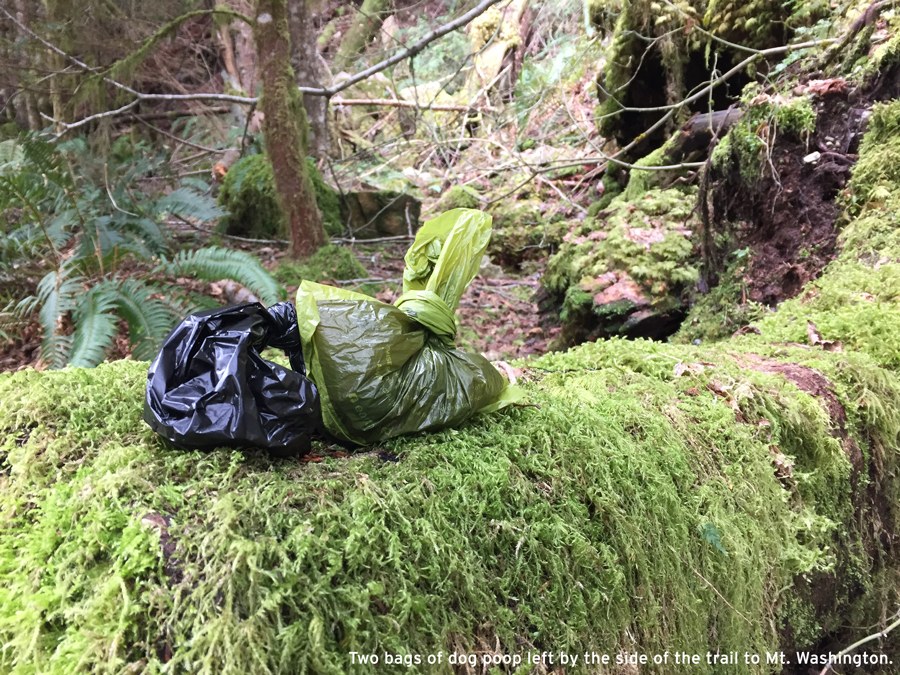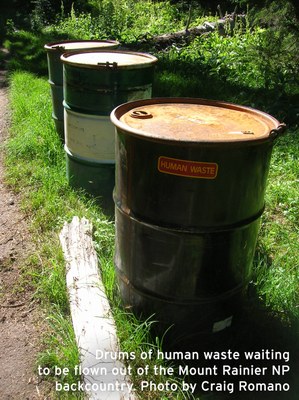
by Craig Romano, Mountaineers Books Guidebook Author
Ahhh, there’s nothing like heading out on your favorite trail to take in the fragrant smells of spring... only to catch the putrid stench of crap. Dog and human alike — it seems lately there’s been a proliferation of poo plopped along our trails and streams of toilet paper flowers soiling our backcountry. And this abundance of trailside turds isn’t just an affront on our visionary and olfactory senses, it’s a major affront to our health and the health of our wild places.
So how did so many of our trails, parks, and forests become open cesspools? The way I see it, there are two major movements in play contributing to our number two problem in the backcountry. Number one is the explosion of new hikers taking to our trails. Many of these newbies are green when it comes to dealing with their browns. They’re not all members of hiking and conservation groups that can enlighten them on the proper way to lighten their loads. Nor are they reading guidebooks with their defecation proclamations. These folks need to be scripted in Leave No Trace principles lest they continue to leave nasty traces all over the backcountry.
The second movement is the proliferation of backcountry campers in fragile environments where there are no or inadequate amounts of privies to accommodate so many mound builders. Have you spent the night at Tuck and Robin lakes, Blanca Lake, or Ancient Lakes lately? You may want to do a fecal coliform check at those lakes and check the waters for finless browns. You simply cannot have thousands of folks and their dogs defecating along the shores of these bodies of water and expect a clean drinking water supply.
The carrying capacity of many of our fragile backcountry lakes is simply being strained by the sheer numbers of people flocking to them. Add their free-flowing feces and we have a backcountry that is not only unhealthy for those of us who recreate there, but for the critters that rely on a pristine water supply. So what can we do about all of this doo doo?
First and foremost our duty is to figuratively raise a stink about this literal stink plaguing our trails. This means we need to educate ourselves and our newbie fellow hikers on the proper way to poop in the woods. Perhaps Kathleen Meyer’s “How to S#&* in the Woods: An environmentally sound approach to a lost art” (Ten Speed Press) should be mandatory reading for all hikers. The book has sold an astonishing 2.5 million copies in eight languages. But there are still millions of others who have not read the book or understand the principles behind it.
The second thing we need to do is call for more backcountry privies for us heeding our calls. Yes, the Forest Service’s budget is crappy, so I don’t expect any expenditures for extraditing excrement. The national park service’s budget is strained too and there’s a long backlog of projects in line before we can address backcountry butt logs. So we may have to look to our conservation leaders and groups to step in before we step in any more poo.
Back in the 1980s, I was a backcountry ranger in the White Mountain National Forest in New Hampshire. One of my duties was literally the s%$# detail. It was one of the crappiest aspects of my job, but one of the most important. Among my responsibilities was working on a composting toilet at a backcountry campsite on the shoulder of 5793-foot Mount Adams. Every week I pulled the large drum from the privy and added wood chips to the “stew.” Then I stirred it all up. It was awful. And it was the only time in my life I dabbled in cigar smoking. To keep the flies away and thwart the stench from reaching my nostrils, I puffed on cherry cigars. We were trained earlier in the season by the good folks of the Appalachian Mountain Club that if we should lose it, just barf right into the drum and stir it up! The stew eventually would become sterile after exposure to heat and sunlight. We would then spread the new soil on Mount Adams’ alpine zone where hikers had previously trampled the fragile environment and braided trails. The composting toilet was brilliant — allowing not only for sanitary disposal of all of those rehydrated dehydrated meals — but also for alpine zone recovery.

I have since had the opportunity to help add to some stews in the Sierras, but sadly not much in the Cascades. We definitely need these rectum receptacles in our cherished backcountry. They’re expensive however and so too are standard backcountry toilets. In areas of thin soils, it may be impossible to keep digging holes and moving toilets. Having drums emptied out each season via helicopter is even more expensive and pretty difficult to do in wilderness areas. In these cases, it may be necessary to blue bag it, as is common practice for alpinists. Dog doo needs to be blue bagged too — and packed out — not left on the side of the trail and forgotten. If folks don’t want to blue bag, and if building backcountry privies is not feasible, we may have to consider the onerous permit and quota system. Some areas like Tuck and Robin simply cannot survive the onslaught of such a s*%$ storm.
So I give you some food for thought the next time you happen to find a backcountry privy to do some s#$%ing and thinking. Maybe it’s time that we work on pushing out focused conservation groups, like People for the Proliferation of Privies, Crapbusters, or Brownpeace. Real groups are out there too. Groups like Access Fund, American Alpine Club, The Mountaineers, and Washington Climbers Coalition (WCC) are currently raising money to build a second toilet at Vantage (www.mountaineers.org/vantagetoilet). The first one, installed four years ago, is already overflowing. But we need more toilets in more places and more people supporting the cause.
We may also have to consider limiting camping in certain fragile overused areas and implementing the use of blue bags at these places. They may seem like inconveniences and an affront to our freedom in the hills, but an abundance of feces in the hills is an affront to our health and overall backcountry experiences; and a deprecation of our wild places. After all, wouldn’t you rather feel pooped after a hike than reel in poop during one?
Craig Romano is an award-winning author who has written and co-written 18 books. His latest release, Urban Trails Bellingham (Mountaineers Books) highlights the best trails for walking, running and hiking in Bellingham, the Chuckanut Mountains, and the Skagit Valley. Other popular titles of Craig’s include 100 Classic Hikes Washington, Day Hiking North Cascades, Backpacking Washington, Urban Trails Kitsap, and more.
Add a comment
Log in to add comments.2 shitty suggestions:
1. Require any permits or parking passes to be accompanied with bags and a quick lecture (or pamphlet) on Leave No Trace.
2. This one is for the trail review sites. Its fantastic for hikers to learn about new trails, but it seems like the masses tend to follow when a hike is newly profiled. Start and end every trail description with a Leave No Trace disclaimer.
I had the misfortune of hiking Bridal Falls early in the season with the toilet still closed and there were piles of shit piled along the side of the outhouse. That's the day I swore off that hike, along with Denny, Lake 22, or anywhere else that attracts 500 people on a weekend day. There's no reason to add my crap to that pile.
Thank you Craig for the important and hilariously enjoyable post!
 Craig Romano
Craig Romano